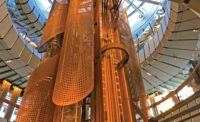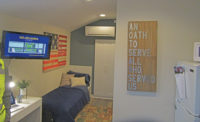Companies working on the $670-million Mississippi River Bridge in St. Louis have shattered geotechnical records with a 36,067-ton load test on one of the bridge’s drilled-shaft, concrete foundations.

The test, performed in June, consisted of drilling an 11.5-ft-dia shaft 43.5 ft under the riverbed, then cutting an 11-ft-dia socket more than 23 ft into the underlying limestone bedrock.
An Osterberg hydraulic load cell was then lowered to the bottom of the rock socket, and reinforced concrete was poured into the shaft to fill the socket and encase the cell.
When the concrete had hardened, hydraulic pumps raised the pressure to the designated level of 36,067 tons.
The socket and pier passed the test, performed by Geotechnology Inc., St. Louis, under the watch of prime contractor MTA Joint Venture, St. Louis, geotechnical engineer Dan Brown & Associates, Sequatchie, Tenn., and testing equipment provider Loadtest Inc., Gainesville, Fla.
The caisson’s confirmed 18,000 tons of end-bearing force and 18,000 tons of side-bearing force are the highest total load ever for any foundation test, say geotechnical engineers.
“There may have been higher per-square-foot pressures, but for total load, this…is the highest ever,” says Dan Brown, the bridge project’s geotech.
Renowned foundation engineer Clyde Baker of STS Consultants/AECOM, Chicago, confirms Brown’s assessment.
“As far as total load, 36,000 tons would be the largest,” Baker says.
The successful test means huge cost and time savings to construction of the massive new Mississippi River Bridge, which will be the country’s third-longest cable-stayed bridge when it is completed in January 2014.
Two concrete foundations will support the bridge’s 1,500-ft-long main span. The successful test verified that using six, 11.5-ft diameter piers—instead of a proposed 14, 10-ft-dia piers—in each foundation will provide ample support.
Using fewer but larger piers will reduce the foundation’s footprints and cut in half the total time needed to construct both piers, from about six months to three, according to Mark Schnoebelen, MTA’s project sponsor and vice president of Massman Construction Co.
Although Schnoebelen would not disclose how much money the alternate approach saves, he categorizes it as “significant.” MTA is a joint venture of Massman Construction Co., Kansas City, Mo., Traylor Brothers Inc., Evansville, Ind., and Alberici Constructors Inc., St. Louis.
MTA and geotechnical engineer Dan Brown & Associates developed the concept of using fewer but larger piers as an alternative before bidding the project to the owners, Missouri Dept. of Transportation and Illinois DOT.
“Drilling the test shaft and doing the load-cell test were designed to verify the geotechnical parameters we assumed in our alternate technical concept,” says Schnoebelen. “The test validates MTA Joint Venture’s approach to constructing the bridge’s foundations and clears the way for MTA to start drilling shafts and pouring concrete.”
The 11-ft-dia shafts are much larger than the typical 5-ft to 8-ft-dia shafts normally used in hard rock to support major bridges, he adds.
The project also is unusual because piers are being excavated using a core-barrel drill that cuts a 6-in. kerf through the rock, then uses a 500-ton jack to snap off the rock core. Production drilling began the first week of August.
div id="articleExtras"

